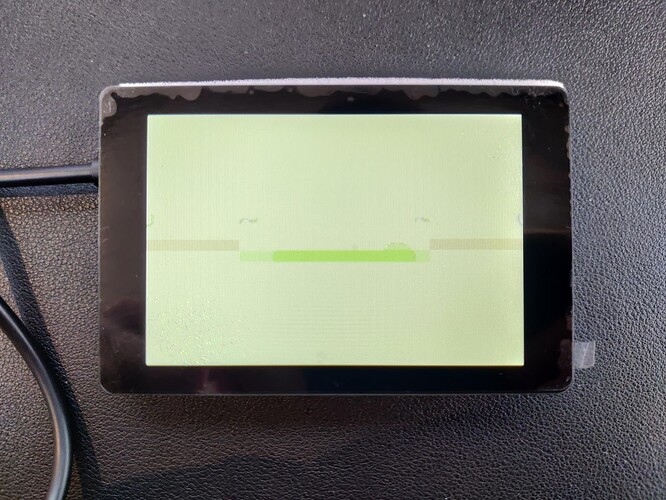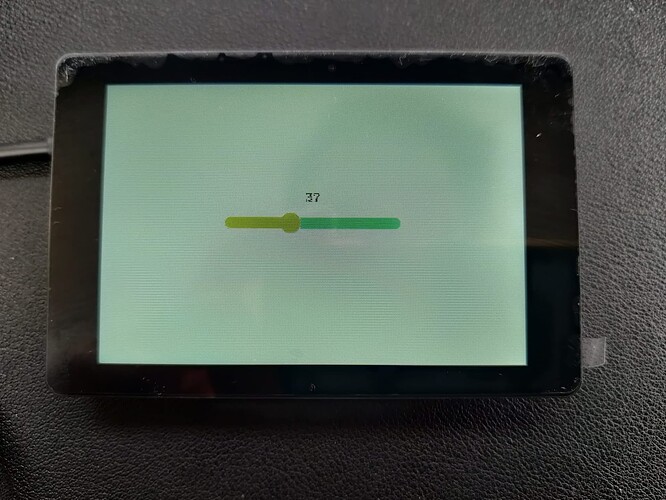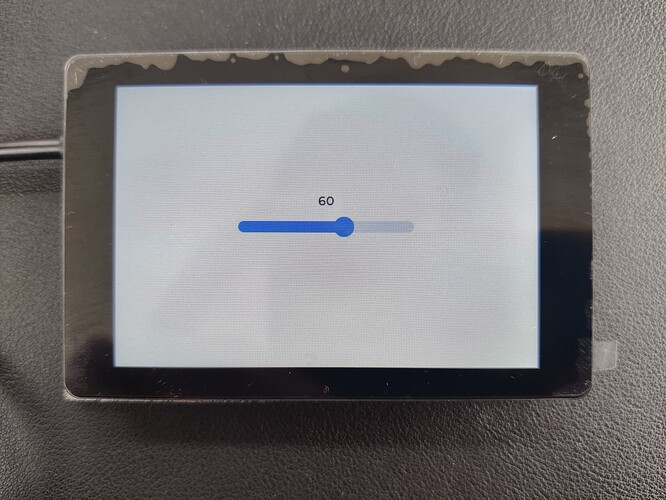I have a WT32-SC01-Plus module and I get a very strange, green-isch, deformed view when using the LVGL library.
When I try a simple LovyanGFX sketch like this, without LVGL, it works fine.
But when I use LVGL I get something like this (it should be a blue-dotted slider bar on a white background):
What can be the issue?
I use Arduino IDE 2.2.1
I use these libraries
- LovyanGFX by lovyan03: v1.1.9
- lvgl by kisvegabor: v8.3.10
lv_conf.h:
lv_conf.h (25.1 KB)
ino file:
/**
Tools
Board: ESP32S3 Dev Module
USB CDC ob boot: enabled!!
Libraries:
- lvgl by kisvegabor: v8.3.10 !! Copy the ...\Arduino\libraries\lvgl\lv_conf_template.h file to ...\Arduino\libraries\lv_conf.h !! Thus, one folder up!
- LovyanGFX by lovyan03: v1.1.9 (Display & touch driver)
*/
/*
Simple Touch Drawing sample for WT32-SC01-Plus_ESP32-S3
Requirements:
- Development board : WT32-SC01-Plus_ESP32-S3
- Arduino Library - Display/Touch : LovyanGFX
- Board selected in Arduino : ESP32S3 Dev Module
*/
#define LGFX_USE_V1 // set to use new version of library
#include <LovyanGFX.hpp> // main library
#include <lvgl.h>
class LGFX : public lgfx::LGFX_Device {
lgfx::Panel_ST7796 _panel_instance; // ST7796UI
lgfx::Bus_Parallel8 _bus_instance; // MCU8080 8B
lgfx::Light_PWM _light_instance;
lgfx::Touch_FT5x06 _touch_instance;
public:
LGFX(void) {
{
auto cfg = _bus_instance.config();
cfg.freq_write = 20000000;
cfg.pin_wr = 47;
cfg.pin_rd = -1;
cfg.pin_rs = 0;
// LCD data interface, 8bit MCU (8080)
cfg.pin_d0 = 9;
cfg.pin_d1 = 46;
cfg.pin_d2 = 3;
cfg.pin_d3 = 8;
cfg.pin_d4 = 18;
cfg.pin_d5 = 17;
cfg.pin_d6 = 16;
cfg.pin_d7 = 15;
_bus_instance.config(cfg);
_panel_instance.setBus(&_bus_instance);
}
{
auto cfg = _panel_instance.config();
cfg.pin_cs = -1;
cfg.pin_rst = 4;
cfg.pin_busy = -1;
cfg.memory_width = 320; // Maximum width supported by driver IC
cfg.memory_height = 480; // Maximum height supported by driver IC
cfg.panel_width = 320;
cfg.panel_height = 480;
cfg.offset_x = 0;
cfg.offset_y = 0;
cfg.offset_rotation = 0;
cfg.dummy_read_pixel = 8;
cfg.dummy_read_bits = 1;
cfg.readable = false; // changed! true
cfg.invert = true;
cfg.rgb_order = false;
cfg.dlen_16bit = false;
cfg.bus_shared = true;
_panel_instance.config(cfg);
}
{
auto cfg = _light_instance.config();
cfg.pin_bl = 45;
cfg.invert = false;
cfg.freq = 44100;
cfg.pwm_channel = 7;
_light_instance.config(cfg);
_panel_instance.setLight(&_light_instance);
}
{
auto cfg = _touch_instance.config();
cfg.x_min = 0;
cfg.x_max = 319;
cfg.y_min = 0;
cfg.y_max = 479;
cfg.pin_int = 7;
cfg.bus_shared = false; // changed! false
cfg.offset_rotation = 0;
cfg.i2c_port = 0; // changed! 1
cfg.i2c_addr = 0x38;
cfg.pin_sda = 6;
cfg.pin_scl = 5;
cfg.freq = 400000;
_touch_instance.config(cfg);
_panel_instance.setTouch(&_touch_instance);
}
setPanel(&_panel_instance);
}
};
LGFX tft;
#define screenWidth 480
#define screenHeight 320
void my_disp_flush(lv_disp_drv_t *disp, const lv_area_t *area, lv_color_t *color_p) {
uint32_t w = (area->x2 - area->x1 + 1);
uint32_t h = (area->y2 - area->y1 + 1);
tft.startWrite();
tft.setAddrWindow(area->x1, area->y1, w, h);
// tft.pushColors(&color_p->full, w * h, true);
tft.writePixels((lgfx::rgb565_t *)&color_p->full, w * h);
tft.endWrite();
lv_disp_flush_ready(disp);
}
void my_touch_read(lv_indev_drv_t *indev_driver, lv_indev_data_t *data) {
uint16_t touchX, touchY;
bool touched = tft.getTouch(&touchX, &touchY);
if (!touched) {
data->state = LV_INDEV_STATE_REL;
} else {
data->state = LV_INDEV_STATE_PR;
data->point.x = touchX;
data->point.y = touchY;
}
Serial.println("in my_touch_read");
}
static lv_style_t label_style;
static lv_obj_t *headerLabel;
static lv_obj_t *label;
static void slider_event_cb(lv_event_t *e) {
Serial.println("in slider_event_cb");
lv_obj_t *slider = lv_event_get_target(e);
/*Refresh the text*/
lv_label_set_text_fmt(label, "%" LV_PRId32, lv_slider_get_value(slider));
lv_obj_align_to(label, slider, LV_ALIGN_OUT_TOP_MID, 0, -15); /*Align top of the slider*/
}
/**
* Create a slider and write its value on a label.
*/
void lv_example_get_started_3(void) {
/*Create a slider in the center of the display*/
lv_obj_t *slider = lv_slider_create(lv_scr_act());
lv_obj_set_width(slider, 200); /*Set the width*/
lv_obj_center(slider); /*Align to the center of the parent (screen)*/
lv_obj_add_event_cb(slider, slider_event_cb, LV_EVENT_VALUE_CHANGED, NULL); /*Assign an event function*/
/*Create a label above the slider*/
label = lv_label_create(lv_scr_act());
lv_label_set_text(label, "0");
lv_obj_align_to(label, slider, LV_ALIGN_OUT_TOP_MID, 0, -15); /*Align top of the slider*/
}
void setup() {
Serial.begin(115200);
tft.begin();
tft.setRotation(1);
tft.setBrightness(64);
setupLvgl();
lv_example_get_started_3();
Serial.println("Setup done - sketch_nov21d.ino");
}
static lv_disp_draw_buf_t draw_buf;
static lv_color_t buf1[screenWidth * screenHeight / 10];
static lv_disp_drv_t disp_drv;
static lv_indev_drv_t indev_drv;
void setupLvgl() {
lv_init();
// Display Buffer
lv_disp_draw_buf_init(&draw_buf, buf1, NULL, screenWidth * screenHeight / 10); /*Initialize the display buffer.*/
// Init Display
lv_disp_drv_init(&disp_drv); /*Basic initialization*/
disp_drv.flush_cb = my_disp_flush; /*Set your driver function*/
disp_drv.draw_buf = &draw_buf; /*Assign the buffer to the display*/
disp_drv.hor_res = screenWidth; /*Set the horizontal resolution of the display*/
disp_drv.ver_res = screenHeight; /*Set the vertical resolution of the display*/
lv_disp_drv_register(&disp_drv); /*Finally register the driver*/
// Init Touchscreen
lv_indev_drv_init(&indev_drv);
indev_drv.type = LV_INDEV_TYPE_POINTER;
indev_drv.read_cb = my_touch_read;
lv_indev_drv_register(&indev_drv);
}
void loop() {
lv_timer_handler();
delay(5);
}
I really appreciate any thoughts on this!


